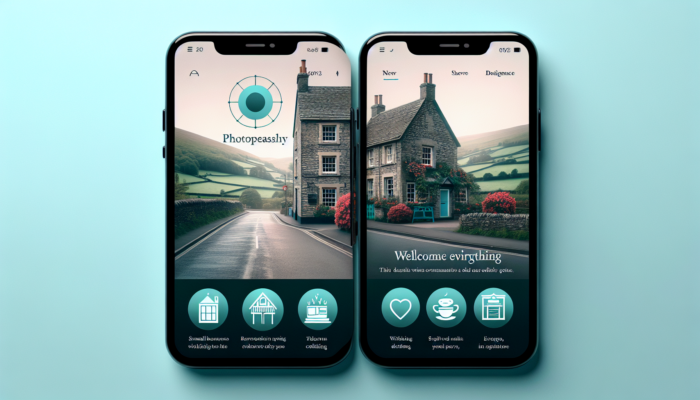Serving Mobile Image Search and surrounding areas for over 25 years.
Trusted by local business for reliable website design, SEO services and Digital Marketing in Somerset, Dorset, Devon, Wiltshire and Gloucestershire. 30 years of online marketing experience across the world.
The Crucial Role of Mobile Image Optimisation in Today's Digital Landscape
Enhancing the User Experience for Mobile Browsers

Optimise for Mobile Image Search: Every online interaction is heavily influenced by the user experience, and with the significant rise in mobile browsing, the necessity of optimising for mobile image search has reached unprecedented levels. Images that load quickly while retaining high quality can significantly improve user satisfaction. Imagine a user navigating their device for inspiration, only to encounter slow loading times and low-resolution images. Such frustrating experiences may lead users to abandon the site altogether. Research indicates that visitors are less inclined to return to a website that fails to deliver a seamless and efficient experience.
Furthermore, mobile users are often on the go, seeking instant access to information. High-quality, appropriately sized images create a smooth flow of content, encouraging users to stay longer and explore your offerings more deeply. This increased engagement not only pleases users but also sends positive signals to search engines, affirming that your site is a valuable resource, thereby enhancing your overall visibility. Investing in mobile image optimisation transcends mere aesthetics; it is about crafting a user-centric experience that nurtures trust and fosters loyalty among visitors.
Understanding the Impact of Image Optimisation on SEO Rankings
Search engine optimisation (SEO) is a multifaceted challenge, and images play a vital role in creating the complete picture. Websites with optimised images often witness improved load times, a crucial factor in search engine ranking algorithms. Studies suggest that even a mere one-second delay in page load times can result in a significant decline in page views and conversions. Thus, by ensuring your images are correctly compressed and optimised, you lay the groundwork for enhanced search engine rankings.
In addition, high-quality and relevant images not only capture user attention but also contribute to increased dwell time. When users interact with your content—whether through images or text—search engines take note. They interpret this interaction as a quality marker, which can further enhance your rankings. Enhanced image optimisation facilitates better indexing by search engines, enabling them to grasp the context and quality of your images, thus boosting your visibility in search results and enhancing your chances of being discovered.
Adapting Your Strategy to Current Mobile Trends
As mobile usage continues to surge, adapting to emerging trends is imperative for maintaining your site's relevance. The transition to mobile-first indexing by major search engines necessitates that your site primarily caters to mobile users. As individuals increasingly depend on their devices for information, providing seamless mobile experiences—including fast-loading, high-quality images—becomes crucial for success.
Staying attuned to current mobile trends, such as the increasing popularity of visual searches, is essential. Users are progressively utilising their mobile devices to search with images rather than text, making image optimisation more vital than ever. By ensuring your images are not only optimised for speed and size but also tailored to meet modern search behaviours, you equip your content to capture a broader audience. This adaptability is a key element in remaining competitive within the ever-evolving digital landscape.
Best Practices for Effective Image Compression

Selecting the Optimal Image Format
When it comes to optimising for mobile image search, the choice of image format significantly influences both quality and loading times. JPEG and PNG are two of the most prevalent formats, each serving distinct purposes. JPEG is ideal for photographs and images with gradients, as it compresses files efficiently without significantly compromising quality. This format is particularly advantageous for e-commerce platforms, where high-quality product images can significantly sway consumer behaviour and decision-making.
Conversely, PNG is more suitable for images that require transparency or those featuring sharp edges, such as logos and illustrations. While PNG files tend to be larger, they offer superior quality for certain types of graphics. Selecting the most appropriate format based on the type of content helps to balance quality and file size, ensuring that images enhance the user experience without unnecessarily burdening loading times.
Beyond merely choosing the right format, it’s vital to understand when to employ additional file formats, such as WebP, which provides an exceptional balance of compression and quality for web use. This knowledge not only aids in achieving faster load times but also enhances your overall SEO performance, ensuring your images are both visually appealing and functionally efficient.
Utilising Advanced Compression Tools for Optimal Results
In an age where user expectations for speed are exceedingly high, implementing effective image compression tools is essential for optimising your images. Tools such as TinyPNG, ImageOptim, and JPEGmini enable web administrators to significantly reduce image file sizes while preserving quality, resulting in faster load times on mobile devices. Regular use of these tools during your content creation process guarantees that images do not become a bottleneck in the user experience, thereby maximising engagement.
Moreover, many content management systems come equipped with built-in image compression features or plugins that automate the process. Automation can save time while ensuring consistency across your image assets. It is crucial to emphasise the importance of this step; poorly compressed images can severely degrade load times, resulting in decreased user satisfaction and heightened bounce rates.
Conducting regular audits of your existing image library using these tools can uncover opportunities to reduce file sizes without sacrificing quality. As a best practice, always optimise images before uploading them to your website, thereby ensuring a proactive approach to enhancing overall performance and user experience.
Achieving a Balance Between Image Quality and File Size

Finding the optimal balance between image quality and file size is a delicate task that can significantly influence both user experience and SEO. High-quality images are essential for capturing interest, but large files can frustrate mobile users due to slow loading times. Therefore, it’s crucial to assess your audience's specific needs and the context in which images will be viewed to determine the best approach.
One effective method for achieving this balance is to utilise progressive JPEGs or variable quality settings during the compression phase. Progressive JPEGs load gradually, initially displaying a lower-quality version of the image, which sharpens as more data is downloaded. This technique can enhance perceived performance, particularly on mobile devices with varying connection speeds, thereby improving the user experience.
Regular testing and gathering feedback from users can inform your strategy regarding the acceptable balance between quality and file size. Implementing A/B testing can help identify the optimal file sizes and formats that meet user needs without compromising your website's visual appeal. Ultimately, an iterative approach to image optimisation will contribute positively to both user experience and search engine rankings.
Implementing Responsive Image Techniques for Optimal Viewing
Utilising the Srcset Attribute for Enhanced Image Delivery
One of the fundamental aspects of optimising for mobile image search is the srcset attribute, which enables web developers to specify multiple image sources for various display scenarios. This responsive technique allows browsers to automatically select the most appropriate image size based on the user's device and screen resolution. By employing srcset, you eliminate the necessity for users to download unnecessarily large images, resulting in faster load times and improved overall performance.
Utilising the srcset attribute is especially beneficial in a world characterised by device variability. From smartphones with diverse screen sizes to tablets and larger displays, implementing an adaptive image strategy guarantees that users receive the best possible visual experience. This technique not only enhances user satisfaction but also aligns with search engine best practices, thereby contributing positively to your overall SEO efforts.
Additionally, srcset offers creative flexibility in delivering images. For instance, you can provide different aspect ratios or even choose to deliver high-resolution images to devices with Retina displays, ensuring that your content appears stunning across all platforms. Paying attention to such details will enhance user satisfaction and retention, reinforcing your brand's commitment to delivering high-quality content.
Maximising the Benefits of the Picture Element for Image Delivery
The picture element works in tandem with srcset, offering an even more refined approach to image delivery. It enables developers to specify various image sources based on specific criteria such as screen width, pixel density, and browser type. This ensures that the most suitable version of an image is delivered, further enhancing loading speeds and overall site performance.
In addition to improving load times, the picture element can be instrumental in serving different image formats, such as WebP, for supported browsers while reverting to older formats like JPEG for those that do not. This versatility ensures that your images are displayed optimally across a wide array of devices, maximising both engagement and accessibility for users.
Effectively employing the picture element requires a nuanced understanding of your audience's needs and behaviours. By analysing user data, you can tailor your image delivery strategy to ensure that you provide visual content that not only captivates but also drives user interaction and engagement.
Implementing Lazy Loading for Improved Performance
Lazy loading is a powerful technique that defers the loading of images until they are required, which can dramatically enhance initial page load speeds. This method significantly improves the user experience on mobile devices, where bandwidth may be limited, and users are often multitasking. By prioritising the loading of visible content, lazy loading can substantially decrease the time it takes for users to access the information they seek.
Integrating lazy loading is straightforward, as many frameworks and libraries provide built-in options for seamless implementation. By loading images only as they enter the viewport, you reduce the initial load burden on mobile devices, allowing users to interact with text and other elements immediately. This approach significantly enhances perceived performance, resulting in increased user satisfaction and engagement.
Furthermore, lazy loading adheres to SEO best practices by reducing overall page weight, which can subsequently lead to improved rankings. Search engines favour sites that prioritise user experience, and optimising for mobile by implementing lazy loading is a commendable step towards achieving that goal, ultimately enhancing your site's performance.
Optimising Image Metadata for Better Searchability
Crafting Descriptive Alt Text for Enhanced SEO and Accessibility
In the realm of optimising for mobile image search, crafting descriptive alt text serves a dual purpose: it bolsters SEO and enhances accessibility. Alt text provides context to search engines, helping them understand the content and purpose of your images. By integrating relevant keywords naturally, you can significantly improve your chances of ranking in image searches, making your content more visible to potential visitors.
Importantly, alt text is not solely for search engines; it is also crucial for users who rely on screen readers. By creating descriptive, meaningful alt text, you ensure that visually impaired users can access the same information as sighted users. This commitment to accessibility not only enhances your brand's reputation but also broadens your audience reach, demonstrating inclusivity and a focus on user experience.
Moreover, employing actionable language in your alt text can encourage user interaction. Instead of merely stating what is depicted in the image, consider how the image connects to your content and what actions you want users to take based on that information. A well-structured alt text can boost engagement and drive conversions by guiding user behaviour while concurrently enhancing your SEO efforts.
Adding Relevant Titles to Boost Image Context
Titles for images play a crucial role in providing additional context, helping both search engines and users understand the content. When optimising images, ensuring that titles are descriptive and pertinent can enhance search engine indexing, making it easier for users to discover your content.
Crafting compelling titles requires a strategic mindset. Incorporating primary keywords while maintaining clarity is essential, as it enhances both SEO and user experience. A well-thought-out title can also contribute to the overall narrative of your content, reinforcing the connection between images and text. This synergy enriches user engagement and can consequently lead to improved retention rates as users find your content more appealing and relevant.
Furthermore, consider the user journey when developing titles. What questions are users asking? What context do they seek? By addressing these considerations, you can create titles that resonate with your audience, ultimately driving more traffic to your site. Enhancing image titles contributes positively to the holistic optimisation of your content, making it more discoverable and engaging.
Incorporating Structured Data for Enhanced Image Visibility
Structured data is an invaluable tool for enhancing image searchability, providing search engines with detailed information about your images. By implementing schema markup, you can specify attributes such as image type, creator, and even licensing, enriching search results with additional context. This enhanced visibility can lead to increased click-through rates and greater user engagement, as users are more likely to interact with well-documented content.
Integrating structured data into your images requires a thoughtful approach. Identify the elements relevant to your audience and content, and implement the corresponding schema types. This initiative not only aids in SEO but also positions your content favourably in rich snippets, boosting its chances of being prominently displayed in search results.
Moreover, staying updated with developments in schema is crucial, as search engines continuously evolve their handling of structured data. By integrating the latest markup elements, you ensure that your images remain competitive in an ever-changing landscape. The benefits of structured data extend beyond SEO; they also enhance user experience by providing clearer, richer search results that can attract and retain visitors.
Mobile-Friendly Image Sizes for Optimal Performance
Understanding Device Variability and User Needs
The variety of mobile devices presents a unique challenge for image optimisation. Understanding the spectrum of screen sizes and resolutions is crucial for effectively tailoring image dimensions. With smartphones, tablets, and laptops all featuring different displays, a one-size-fits-all approach is inadequate for delivering an optimal user experience.
Responsive design principles advocate for images that adapt seamlessly to the user's device, ensuring optimal presentation regardless of screen size. Consider leveraging CSS techniques to adjust image size and display, facilitating a fluid user experience. This strategy not only caters to visual appeal but also enhances performance, as users won’t be compelled to download unnecessarily large images that could impair their experience.
Regularly analysing access data can help identify the predominant devices used by your audience. By tailoring your image strategy based on this analysis, you can ensure that users receive an optimal experience, fostering greater engagement and satisfaction as they interact with your content.
Scaling Images Appropriately for Diverse Devices
Scaling images for mobile devices involves a strategic approach that prioritises both visual quality and performance. It is crucial to ensure that images maintain their clarity and detail while being appropriately sized for different devices. This is where responsive images and techniques, such as the Picture Element (PElement), become invaluable, allowing images to scale dynamically based on device specifications.
Additionally, using CSS to adjust the display size of images ensures that they appear sharp and visually appealing across different devices. Regular reviews of your site's images can help identify areas where scaling is necessary, ensuring that users receive a well-optimised experience that keeps them engaged with your site.
Incorporating automatic scaling solutions, such as those provided by many content delivery networks (CDNs), can further enhance performance by serving the appropriately sized image based on the user's device. This proactive approach not only improves load times but also positively contributes to the user experience, ensuring seamless interaction and satisfaction.
Avoiding Oversized Images for Improved Performance
Oversized images represent a common pitfall that can severely affect mobile site performance. Images that are too large not only slow down loading times but can also lead to increased bounce rates as users abandon pages that take too long to display. It is essential to evaluate all images before uploading them to ensure that they are appropriately sized for web use, thus maintaining an efficient user experience.
Utilising tools to analyse and optimise image file sizes can uncover oversized images that can be compressed without compromising quality. Regular audits of your image library can help maintain optimal performance, ensuring that users enjoy a swift browsing experience that keeps them engaged with your content.
By proactively managing image sizes and continually refining your image strategy, you position your site for success in search engine rankings and user engagement. In the realm of mobile browsing, speed is not merely a luxury; it is a necessity that directly influences user satisfaction.
Optimising Image File Sizes for Enhanced Loading Speeds
Reducing image file sizes is a critical step in optimising for mobile image search and overall site performance. Large files can impede loading times, resulting in diminished user satisfaction and engagement. Techniques such as image compression and format selection are vital in this optimisation process.
Adopting tools that specialise in image optimisation can drastically reduce file sizes while preserving visual integrity. These tools often facilitate bulk processing, making it easier to manage larger libraries of images efficiently. Regularly revisiting your existing images to apply these optimisations can lead to significant improvements in site speed, benefiting both users and search engines.
Encouraging a culture of image optimisation within your content creation team ensures that all new images are subject to these practices. Establishing guidelines for image sizes and formats promotes consistency and enhances the overall user experience. By prioritising file size management, you improve loading times, ultimately leading to higher engagement rates and better search engine rankings.
Enhancing Image Discoverability Through Strategic Approaches
Leveraging Social Media for Increased Visibility
Social media serves as a powerful tool for enhancing the discoverability of your images and driving traffic to your site. Platforms like Instagram, Pinterest, and Facebook thrive on visual content, making them excellent avenues for sharing your images. By crafting visually appealing posts accompanied by engaging captions and relevant hashtags, you can capture the attention of potential visitors and increase your content's reach.
Encouraging users to share your images amplifies your visibility even further. User-generated content and shares play a significant role in increasing trust and engagement. By creating images that resonate with your audience, you foster a sense of community that can lead to organic growth and a loyal following around your brand.
Moreover, integrating social media sharing buttons on your website can facilitate the sharing process, encouraging visitors to promote your content. This strategic action can significantly enhance your image's online presence, driving traffic back to your website while also boosting your SEO through increased backlinks and social signals that search engines value.
Utilising Image Sitemaps for Improved Indexing
Image sitemaps are an underutilised resource that can dramatically enhance the search engine indexing of your images. By creating a dedicated sitemap for your images, you provide search engines with explicit information about your content, which can result in improved visibility in search results. This is particularly critical for sites with extensive image libraries where discoverability is paramount.
When creating an image sitemap, ensure that you include relevant details such as image titles and captions. This information helps search engines understand the context of your images, increasing the likelihood that they will appear in search results. Regularly updating your sitemap can keep search engines informed of new content, ensuring that your images remain discoverable and relevant.
Additionally, integrating schema markup for images within your sitemap can enhance the details provided, further aiding in search engine performance. This proactive approach can lead to increased traffic and higher rankings, ultimately enhancing the overall effectiveness of your SEO strategy by making your content more accessible and discoverable.
Engaging with Visual Search Technologies
The rise of visual search technology is transforming how users discover content online. Optimising for visual search involves ensuring that your images are correctly tagged, have appropriate alt text, and are of high quality, allowing search engines to index them effectively. As platforms like Google Lens and Pinterest Lens gain traction, ensuring your images are discoverable through these means is crucial for maintaining relevance.
One effective strategy is to focus on creating rich, high-quality images that are contextually relevant to your content. Ensuring that images align with user intent can significantly improve the chances of appearing in visual search results. Additionally, encouraging users to engage with your images in ways that promote discovery can enhance your visibility in this burgeoning field of search.
Staying informed about developments in visual search technology and adapting your image optimisation strategies accordingly will position your content favourably in search results. As visual search continues to evolve, those who prioritise these strategies will reap the rewards in terms of visibility and user engagement.
Monitoring and Analysing Image Performance for Continuous Improvement
Tracking Image Load Times for Optimal Performance
Understanding how quickly your images load on mobile devices is a fundamental aspect of optimising for mobile image search. Tracking load times enables you to identify specific images that may be hindering performance, allowing for targeted optimisation initiatives. Tools like Google PageSpeed Insights and GTmetrix can provide valuable insights into image load times and overall site performance, allowing you to pinpoint areas for improvement.
Regular monitoring can reveal patterns and trends, helping you adapt your strategy to meet evolving user expectations. For instance, if certain images consistently load slowly, it may indicate a need for further compression or format alterations. By addressing these issues promptly, you can enhance user experience, reduce bounce rates, and improve overall site efficacy.
Incorporating load time metrics into your overall performance analysis can provide a comprehensive view of your site's effectiveness. By establishing benchmarks and goals for image load times, you create a roadmap for continuous improvement, ensuring that your images contribute positively to user engagement and search engine rankings.
Analysing User Engagement to Inform Image Strategy
User engagement metrics offer valuable insights into how users interact with your images. Tools like Google Analytics can help track metrics such as clicks, shares, and time spent on pages featuring images. By analysing this data, you can identify which images resonate most with your audience and adapt your strategy accordingly to enhance engagement and satisfaction.
Understanding user behaviour informs your image optimisation efforts. For example, if specific images consistently yield higher engagement rates, consider creating more content in a similar style or theme. This data-driven approach ensures that your content aligns with audience preferences, fostering greater interaction and satisfaction as users find your visual content more appealing.
Moreover, conducting A/B testing with different images can provide clarity on user preferences, allowing you to refine your approach further. By continually adapting your strategy based on user engagement, you can amplify the effectiveness of your images and enhance overall site performance, ultimately aiming for a more satisfying user experience.
Utilising Analytics Tools for Data-Driven Decisions
Analytics tools are indispensable for gaining insights into your image performance and user behaviour. By leveraging platforms like Google Analytics, you can track essential metrics such as page views, bounce rates, and user journeys, allowing you to identify how images contribute to your site's overall success and user engagement.
These tools can also help segment data by device type, revealing how mobile users interact with your images differently from desktop users. Understanding these nuances enables you to tailor your image strategy to meet the specific needs of your audience, ensuring a more effective and satisfying user experience across all platforms.
Regularly reviewing analytics data can inform your optimisation efforts, enabling you to make data-driven decisions that enhance user experience. By identifying successful strategies and areas for improvement, you can refine your approach, ensuring that your images not only attract users but also keep them engaged, ultimately leading to improved performance and satisfaction.
Evaluating Server Response Times for Optimal Performance
Server response times are a crucial factor influencing the performance of your images. Slow server responses can lead to delays in image loading, negatively impacting user experience and SEO. Regularly monitoring server performance helps ensure that your images are delivered promptly and efficiently, thereby contributing to a positive overall user experience.
Utilising tools like Pingdom and WebPageTest can provide insights into your server response times, allowing you to identify bottlenecks that may hinder performance. If certain images consistently exhibit slow loading times, it may indicate a need for server optimisation or adjustments to your hosting plan to accommodate traffic demands.
Incorporating a content delivery network (CDN) can significantly enhance server response times by distributing your images across various locations. This approach reduces the load on your primary server. It ensures that images are served from the closest geographical location to the user, improving load times and overall site performance, which is critical for mobile users.
Assessing Image Compression Efficiency for Continuous Improvement
Analysing the effectiveness of your image compression efforts is crucial for striking the right balance between quality and performance. By evaluating how compression impacts both load times and visual quality, you can make informed decisions regarding your image optimisation strategy.
Regularly comparing compressed images with their original counterparts can provide insights into the effectiveness of your chosen compression techniques. If certain methods lead to noticeable quality degradation, it may be time to explore alternative tools or settings that better suit your needs and objectives.
Additionally, tracking the impact of image compression on loading times can guide ongoing optimisation efforts. By continually refining your approach based on performance metrics, you ensure that your images remain both visually appealing and efficient, contributing to a more satisfactory user experience as visitors engage with your content.
Frequently Asked Questions About Mobile Image Optimisation
What is mobile image optimisation?
Mobile image optimisation encompasses a range of techniques and strategies designed to enhance the performance and loading times of images on mobile devices, thereby improving both user experience and search engine visibility.
Why is image size important for mobile sites?
Image size directly influences loading times; larger images can slow down mobile sites, leading to higher bounce rates. Conversely, optimised images enhance user engagement and satisfaction by ensuring a smoother browsing experience.
How does alt text benefit SEO?
Alt text helps search engines understand the content of images, thereby improving SEO by enhancing image indexing and providing context, which can lead to better visibility in search results and increased traffic.
What tools can I use for image compression?
Tools such as TinyPNG, ImageOptim, and JPEGmini are popular for compressing images without significant loss of quality, ensuring faster load times on mobile devices and enhancing overall site performance.
What is lazy loading?
Lazy loading is a technique that defers the loading of images until they are needed, thereby improving initial page load times and enhancing user experience, particularly on mobile devices with limited bandwidth.
How can I improve my website's SEO image?
Enhancing image SEO involves using descriptive alt text, optimising image sizes, applying structured data, and creating image sitemaps to improve discoverability and increase the likelihood of appearing in search results.
What is the impact of server response times on images?
Slow server response times can result in delayed image loading, negatively impacting user experience and potentially leading to lower search engine rankings due to increased bounce rates and decreased engagement.
What role do social media platforms play in image discoverability?
Social media platforms are pivotal for sharing images, increasing visibility, and driving traffic to your site, thereby enhancing overall discoverability and user engagement through organic sharing and community interaction.
How can I use analytics to optimise my images?
Analytics tools facilitate tracking image performance metrics, user engagement, and load times, enabling you to make data-driven decisions that inform your ongoing optimisation strategies for improved user experience.
What is the picture element, and why is it useful?
The picture element allows developers to specify different image sources for varying display conditions, optimising loading speeds and ensuring optimal presentation across devices, which is crucial for mobile user experience.


















3 Comments
You’ve highlighted a critical aspect of user experience with mobile browsing that often gets overlooked—the balance between speed and quality. It’s intriguing to think about how our expectations for instant access have evolved. When I consider my own browsing habits, I realize that I will quickly abandon a site that doesn’t load images fast enough, even if the content is compelling.
Your insights on mobile image optimization really resonate with the current challenges faced by web designers and marketers alike. It’s striking how much the quality and loading speed of images can influence user engagement, especially as we increasingly rely on mobile devices for instant access to information. Personally, I’ve experienced frustration with sites that prioritize visuals but neglect optimization. It’s not just about aesthetics—when a page takes too long to load, I often find myself shifting to a competitor’s site that offers a smoother experience.
I totally agree with your points about mobile image optimisation being essential for user experience. It’s wild how dependent we are on our phones, and you see that frustration firsthand when sites have slow-loading images or those tiny thumbnails that leave you squinting! I’ve found that on-the-go users like myself will quickly move on to another site if the visuals aren’t up to par. It’s like we expect instant gratification, right?